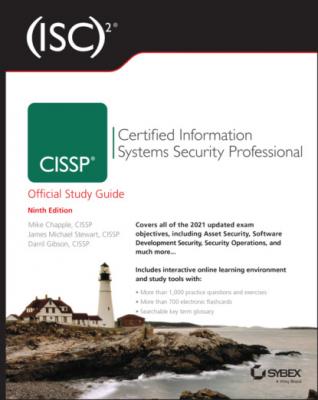(ISC)2 CISSP Certified Information Systems Security Professional Official Study Guide. Mike Chapple
Чтение книги онлайн.
Читать онлайн книгу (ISC)2 CISSP Certified Information Systems Security Professional Official Study Guide - Mike Chapple страница 82
 report types at www.aicpa.org/interestareas/frc/assuranceadvisoryservices/serviceorganization-smanagement.html.
report types at www.aicpa.org/interestareas/frc/assuranceadvisoryservices/serviceorganization-smanagement.html.
Likelihood Assessment
The preceding step consisted of the BCP team's drawing up a comprehensive list of the events that can be a threat to an organization. You probably recognized that some events are much more likely to happen than others. For example, an earthquake is a much more plausible risk than a tropical storm for a business located in Southern California. A company based in Florida might have the exact opposite likelihood that each risk would occur.
To account for these differences, the next phase of the business impact analysis identifies the likelihood that each risk will occur. We describe this likelihood using the same process used for the risk assessment in Chapter 2. First, we determine the annualized rate of occurrence (ARO) that reflects the number of times a business expects to experience a given disaster each year. This annualization process simplifies comparing the magnitude of very different risks.
The BCP team should sit down and determine an ARO for each risk identified in the previous section. Base these numbers on corporate history, professional experience of team members, and advice from experts, such as meteorologists, seismologists, fire prevention professionals, and other consultants, as needed.
In many cases, you may be able to find likelihood assessments for some risks prepared by experts at no cost to you. For example, the U.S. Geological Survey (USGS) developed the earthquake hazard map shown in Figure 3.1. This map illustrates the ARO for earthquakes in various regions of the United States. Similarly, the Federal Emergency Management Agency (FEMA) coordinates the development of detailed flood maps of local communities throughout the United States. These resources are available online and offer a wealth of information to organizations performing a business impact analysis.
FIGURE 3.1 Earthquake hazard map of the United States
Impact Analysis
As you may have surmised based on its name, the impact analysis is one of the most critical portions of the business impact analysis. In this phase, you analyze the data gathered during risk identification and likelihood assessment and attempt to determine what impact each one of the identified risks would have on the business if it were to occur.
From a quantitative point of view, we will cover three specific metrics: the exposure factor, the single loss expectancy, and the annualized loss expectancy. Each one of these values describes a particular risk/asset combination evaluated during the previous phases.
The exposure factor (EF) is the amount of damage that the risk poses to the asset, expressed as a percentage of the asset's value. For example, if the BCP team consults with fire experts and determines that a building fire would destroy 70 percent of the building, the exposure factor of the building to fire is 70 percent.
The single loss expectancy (SLE) is the monetary loss expected each time the risk materializes. You can compute the SLE using the following formula:
Continuing with the preceding example, if the building is worth $500,000, the single loss expectancy would be 70 percent of $500,000, or $350,000. You can interpret this figure to mean that you could expect a single fire in the building would cause $350,000 worth of damage.
The annualized loss expectancy (ALE) is the monetary loss that the business expects to suffer as a result of the risk harming the asset during a typical year. The SLE is the amount of damage you expect each time a disaster strikes, and the ARO (from the likelihood analysis) is the number of times you expect a disaster to occur each year. You compute the ALE by simply multiplying those two numbers:
Returning once again to our building example, fire experts might predict that a fire will occur in the building approximately once every 30 years, specifically determining that there is a 0.03 chance of a fire in any given year. The ALE is then 3 percent of the $350,000 SLE, or $10,500. You can interpret this figure to mean that the business should expect to lose $10,500 each year due to a fire in the building.
Obviously, a fire will not occur each year—this figure represents the average cost over the approximately 30 years between fires. It's not especially useful for budgeting considerations but proves invaluable when attempting to prioritize the assignment of BCP resources to a given risk. Of course, a business leader may decide that the risk of fire remains unacceptable and take actions that contradict the quantitative analysis. That's where qualitative assessment comes into play.
From a qualitative point of view, you must consider the nonmonetary impact that interruptions might have on your business. For example, you might want to consider the following:
Loss of goodwill among your client base
Loss of employees to other jobs after prolonged downtime
Social/ethical responsibilities to the community
Negative publicity
It's difficult to put dollar values on items like these to include them in the quantitative portion of the impact analysis, but they are equally important. After all, if you decimate your client base, you won't have a business to return to when you're ready to resume operations!
Resource Prioritization
The final step of the BIA is to prioritize the allocation of business continuity resources to the various risks that you identified and assessed in earlier phases of the BIA.
From